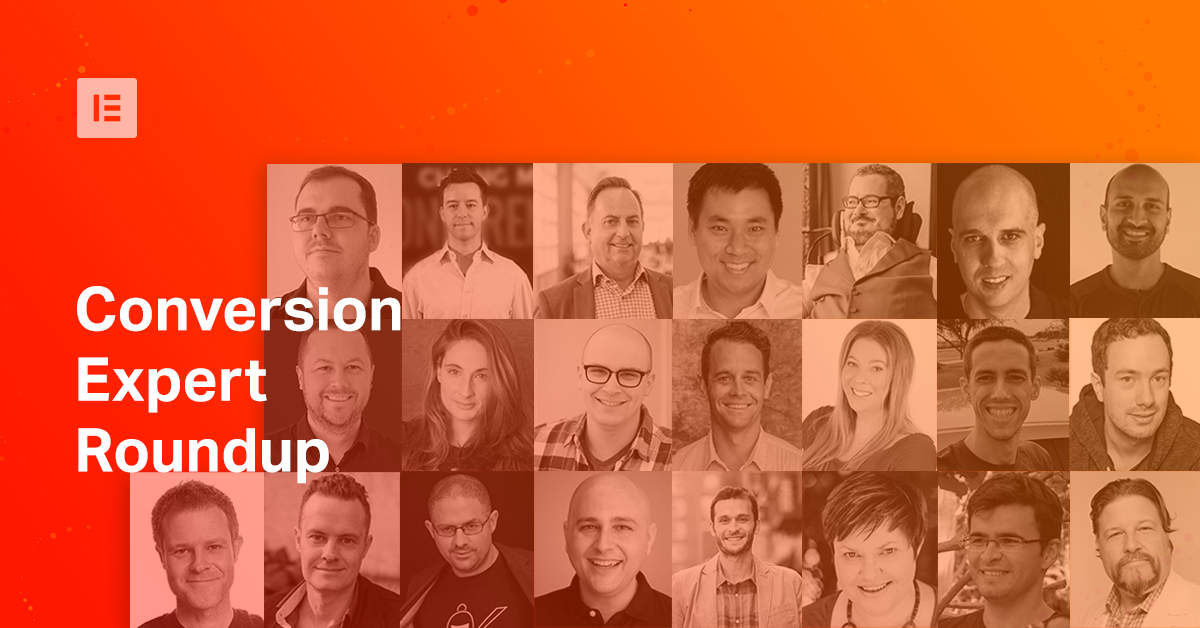Table of Contents
If there is one great investment you KNOW your business should make – it’s improving your site’s conversions.
Unlike getting more traffic, which requires performing a long list of tasks, getting more conversions is sometimes as easy as rephrasing a sentence.
In terms of website conversions, there is always room for improvement. A website is THE single source of business for you, and your site could probably generate far more leads and conversions if you just did more tests, added more popups; optimized it for more conversions.
This ‘website FOMO’ is inevitable, but you can meet the challenge and work to keep improving conversions. If you decided to do just that – where would you start?
To help you figure this out, we asked top CROs, marketing and website building experts for their most relevant conversion tips for 2019.

Jeff Bullas
Digital Marketing Expert & CEO at Jeffbullas.com
Use Facebook ads with video to increase your conversion rates. We use the “Video in a Box” ShuttleRock technology product to do this at scale. Then test, test, and test.
Implement Facebook Messenger Chatbots to build your FB messenger subscriber list. These get insane conversion rates.
Don’t forget to continue to work on your email list building and optimization.

Larry Kim
CEO of MobileMonkey, Founder of WordStream
Facebook Messenger Ads –
This is a new Facebook Ad format that sends you user contact information and gives you permission to send them messages, every time someone clicks on your ad. So instead of sending traffic directly to your website from a Facebook Ad, have them go to your chatbot, then to you website, thus generating a 100% conversion rate.
Facebook Messenger Chat Blasting –
As you build up a big subscriber lists via from your Facebook Messenger ad campaigns, send them information about your business as you would do using email. The difference is that sending through chat generates 100x more engagement. Re-use all your cart-abandonment or special emails, and send them out through Facebook Messenger as well!
Facebook Messenger Drip Campaigns –
On average, only 2% of the people who visit your site end up converting to a lead or sale. By opting visitors into a drip campaign, you can send them valuable information to help them get to know you more and build brand affinity, so that they have a better chance of converting in the near future.
In summary, keep doing the website CRO that you are already doing, but strongly consider adding or upgrading the communication channel you use to connect with your prospective customers from just email, to also including chat marketing, which is the preferred communication method for most people.

Sujan Patel
Right Inbox Co-founder
Test different types of money-back guarantees. If your main competitors offer 30-day guarantees, make yours 60 days.
Test 5-10 different colors of your CTA button.
Speed up your site. There’s nothing worse than waiting for a site to load properly.

Talia Wolf
Conversion Optimization Specialist at GetUplift
When it comes to optimization, tactics, best practices and “hacks”, rarely work. Thousands of AB tests have shown time and time again that changing the color of a button, the headline or removing a field in a form isn’t where true growth lies, true growth lies in customer-centric optimization. All the analytics, tools, automation and data in the world won’t get you the uplifts you need, not if you are missing the key that brings them all together.
If you want to start creating landing pages, websites and campaigns, people love to convert to, you have to master the one skill that matters more than anything in the world: selling with emotion.
When looking at the data, it’s easy to know where the problem is (a landing page, an ad, or maybe your pricing page), the hard part, is figuring out how to fix it and what changes to make on that page. Only once you understand your customers’ true intent, their emotional-drivers and how they make purchasing decisions, can you choose the right messages, images and colors that will increase conversions.

Lilach Bullock
Lead Conversion Expert & Acclaimed Speaker
One of my top priorities this year regarding website conversions is to make sure that any relevant information and my most important Calls-to-Action are clearly visible at the top of my pages, with no scrolling necessary: my lead generation form, links to connect with me, information about who I am and what I can do.
This year, I’m also planning to leverage my analytics more: I want to truly understand why some lead generation forms work better than others, why some calls to action generate more leads and customers, why certain content is performing better and so on. And most importantly, I want to make sure that I’m leveraging these insights to build a better website and create better content.
And last but definitely not least, personalization will be another top priority this year; this will require a lot of research and insights into who forms your target audience so that you can use that knowledge to deliver personalized content on your website, whether it’s your blog, your landing pages and pretty much any sales page on your website.

Jon Morrow
Founder of SmartBlogger
As the billionaire Ben Horowitz says, “There are no silver bullets, only lots of lead bullets.” In other words, there is no magical strategy, channel, app, or offer that will fix your conversion numbers for you. More than likely, you’re going to have to try lots of different things to hit your conversion goals.
The best place to start testing is always your offer. Not colors, not button text, none of that crap. You need to test making different types of promises to different types of customers. The difference between the right offer and the wrong one can be 100X sales, so find that first, and then focus on the incremental gains in other areas.
If you’re wondering if your offer is good enough, ask yourself this: does the customer feel foolish for saying no? You want your offer to be so good, so irresistible that only an idiot declines, and they are kicking themselves over it for weeks. If that isn’t happening, your offer isn’t good enough and you need to step up your game.

Brian Massey
Founder & Conversion Scientist™ at Conversion Sciences
Look at a full year’s worth of ad data. Get a spreadsheet of all your paid search ads with text, impressions, clicks, cost, and conversions (if you track that). Sort by impressions. Which high-impression ads generated the most clicks? The most conversions? What words seemed most effective? Which Calls-to-Action? What URLs were these ads aimed at?
Download a full years’ worth of email data. Sort performance by click-through rate. What subject lines performed the best? What words showed up most often? What offers and calls-to-action were most effective?
Use what you’ve learned on your landing pages. Use the words used in the ads. Create lead magnets that address high-performing concepts from your ads and emails. Offer these lead magnets on your landing pages.
Create landing pages for those ad clicks and email clicks that go to the homepage or generic website pages (like category pages on ecommerce sites or generic information pages on lead generation sites). These are probably underperforming.

Ron Sela
Owner at Ron Sela Digital
Leverage High-Value Keywords in CTAs –
Your Call-to-Action needs to be strong enough to persuade people to jump on board. What could be better than using the language your prospects use themselves?
With solid keyword research, you can discover keywords that are already bringing traffic to your site, and then incorporate them in your CTAs.
By aligning your copy with user intent, you can connect with site visitors, effectively capitalizing on existing traffic to boost your conversion rate.
Phrases like “submit” and “sign-up” are worn out. Instead, try more engaging Call-to-Action phrases to present your CTA in a more appealing way.
Focus on the Benefits, Not Features –
I’m sure your product is wonderful. But guess what?
Nobody cares about all the fancy features – your prospects just want to know how it will help them.
You must sell solutions to problems, highlighting the value of each feature in a benefits-led pitch that conveys the true, tangible gain someone will receive from using your product or service.
Use High-Quality Video Testimonials –
Like an unstoppable juggernaut, video content is rapidly becoming the dominant force of modern marketing. So, how can you use it best?
When it comes to selling products, two things matter more than most right now: Trust and personalization.
With video testimonials, your company can implement personalization effectively to build social proof, through the valued backing of a happy customer or major success story.
In doing this, you will find it easier to establish trust with prospects, which in turn leads to more conversions.

Donna Moritz
Visual Content Strategist at Socially Sorted
Ask or survey your audience about what their biggest obstacle, challenge or pain is when it comes to the service or product you offer. The more you can get to know their problems and challenges, the better you can solve them. This carries right through to your website language, web-page features, forms, buttons and #AllTheThings. If you don’t know what problem you are trying to solve, all that stuff won’t work as it should.
Warm up your audience so that when they get to your website they already know you well. Search traffic is great, but think about how to bring in some warm traffic too. If people know you via your email list or your Instagram stories or video, they’ll be more than happy to click through when you ask them to visit your new blog post or podcast post. It’s a little harder to ask them if they don’t know who in the heck you are!
In the age of bots, bots and more bots, being human is one of the best ways you can convert a subscriber or customer. Have a chat plugin by all means, but if you can add human responses to it (not just bots) you’ll build trust and affinity with your audience.
Think about how you can engage people who come to your site. It could be that you jump into the bot conversation at a certain point with a real, live human. It could be responding to blog comments like a friend, or asking a question to encourage a response from new subscribers in your email onboarding sequence. Or just a friendly, warm video on your landing page. Use bots by all means… but back them up with “human”. My hunch is that the more automated things get, the more our species will crave this.

Joel Klettke
Conversion Copywriter and CRO Consultant
Using headlines/highlights for displaying testimonials –
Often, companies slap on a HUGE testimonial or a block of text with a headshot and just hope people will read them.
In some situations, it makes sense to add a brief headline to the testimonial emphasizing the most important quote or overall theme from the testimonial. Or, you can use highlighting (like Case Study Buddy does on their home page testimonials) to draw attention to a compelling part of the story.
Use “even if” lists to overcome objections –
If you’re trying to help a lead realize if your solution is right for them, giving them a list of “even if” reasons that counter their objections can be extremely effective.
For example: “This SEO course is right for you, even if you’ve never built a link in your life, don’t know what ‘metadata’ means, and have less than an hour per week to spend learning the craft.”
Use chat logs to find gaps in information on your landing pages –
Not sure what’s missing from your content? Deploy chat for a short period and see what sorts of questions leads are asking.
These may be high-priority things leads aren’t able to quickly locate and find answers to on your page (gaps) – or if they are on your page, they’re too buried for some leads to find.

Gael Breton
Co-Founder of Authority Hacker
How to Increase Trust –
Nowadays, users are accustomed to beautiful, perfectly proportional interfaces via their operating system of choice (iOS, Android, MacOS, Windows10), and the browsers also look sleek (both Chrome and Firefox were vastly modernized in 2018).
What that means for you is that if your site does not have the same standards and your branding is all over the place, or your responsiveness is questionable, it sticks out like a sore thumb, and the trust in anything you present the user will drop instantly.
Luckily, the guys over at Elementor released the ‘Theme Builder’ in 2018 and this is something you should be able to use if you have a PRO license. We did it on our site with great success.
We managed to increase time on page by 50% and pages visited by almost 22%. This is the first step to higher conversions: increase the attention of the user.
How to Increase Relevance –
Once you’ve got your user’s attention, the next most important thing is to present them with a Call-to-Action that’s relevant to why they are on your site in the first place.
I see way too many people produce content that gets traffic, then offer something completely different than what the post is about on the call-to-actions around their blog content, and wonder why they don’t get any conversions.
So, if they came to read about how to DIY a logo, present them with a logo design service.
Don’t try to sell them your full design service, don’t try to sell them SEO. Sell them something directly related to the content they came for.
If you don’t offer such products or services in-house, you can either work on creating it if the page is getting massive traffic or just use affiliate offers to promote other people’s products and get paid for it (we’ve compiled a long list of affiliate programs here if you need some help).
Also once you have a very relevant offer, don’t be afraid to put in content Call-to-Actions. Don’t just rely on your sidebar that doesn’t show on mobile and post/pre-content CTA’s. Put them smack in the middle where people are paying attention.
Since they’re so relevant now they won’t feel out of place and your conversions will soar.
How to Increase Buyer Temperature –
Now you’ve got their attention, you have the relevant call to actions, you need to raise buyer temperature and get your readers excited, so they build up the motivation to take action and fill in forms, pay, engage etc.
How do you do that?
First, you go above and beyond in the content you provide.
Really focus on standing out from what everyone else is doing. Most likely, if a prospect is interested in a topic, they will read from you but also from your competitors. If you stand out, they’ll be the most excited by your stuff.
Second, tell stories.
Stories allow us to put ourselves in the shoes of the featured character. So if your product solves a pain point for your buyers, tell the story of your previous customers and how their life changed after solving the problem you helped them with.
Your potential buyers will picture it and build up the motivation to take action.
It also flips the script from the purchase being a rational decision to an emotional one. And convincing emotionally engaged people is so much easier ;).

Troy Dean
Founder and CEO of WPElevation
Use a two-step opt-in for lead magnets. That means a user clicks the button and enters their name and email in a pop-up form. The micro-commitment of clicking the button to show the form increases conversions.
Use a two-step checkout form. That is, the customer enters their name and email address first to create their account and then they enter their payment details to buy. Again the micro-commitment of entering their personal details first increases conversions PLUS you get the added benefit of capturing their email address, so if they abandon cart you can follow up.
Finally, cart abandonment campaigns to remind people to complete their order with a link that takes them back to their order form with their name and email already filled in.

Brian Jackson
Chief Marketing Officer at Kinsta
My first recommendation would be to always keep testing new strategies. If you aren’t A/B testing, you should be. This is one of the only ways to make the correct data-driven marketing decisions when it comes to things like ad copy, landing page copy, CTAs, etc. I’m a big fan of Google Optimize right now, and it’s free!
My second recommendation, and while it might sound like a broken record at this point, is to invest in content marketing! SEO is a long-term play, but one that pays off in leaps and bounds. For those doing it correctly, SEO is almost always the number one source of conversions, as well as the highest quality source.
However, don’t expect anything for the first six months. Just keep at it, and you should start seeing results. Write for the user, but be smart about it. Do keyword and topic research. Don’t write about things if there is no volume. Find something that will help both the user and can be found in SERPs. Also, don’t bother with under 1,000-word articles. Quality is usually more important than quantity in most industries.
My third recommendation is to find a social media network that works for you, and up your skills with it. The network will vary per industry. For me, Twitter has been my secret sauce.
People a lot of times mistake social media as just another traffic source, but I’ve signed up Enterprise clients and scheduled meetings with agency partners all via Twitter DMs. It’s amazing what can be done. Find where your customers are, and then use what they are using, whether this is Facebook groups, Twitter, Pinterest, etc.
Most networks then have ways to get even better at them. For example, I use Tweetdeck and have all sorts of filters running so I can see mentions of specific keywords, competitors, and even new content ideas. All of these little tricks help me connect with more potential clients and form new relationships, which in turn, results in more conversions.

Adam Preiser
YouTuber & Founder of WPCrafter
Remember the “5-Second Rule”. Someone that visits your website should know within 5 seconds what your business is and what’s in it for them. Print out a picture of your homepage and show it to someone that doesn’t already know what you do, and ask them after 5-10 seconds what they think your website is about. If they don’t know after 5 seconds then you need to work on your headline, sub-headline, and any images on your homepage.
Make it easy for people to reach you. Consider putting your main Call-to-Action in the top right area of your website, such as your phone number or a link to a contact form.
People buy from people. Consider placing a picture of you or your staff on your website in obvious locations. Maybe even a personal message where you speak directly to your visitors.

Tal Florentin
UX Specialist and Founder at Summurai
Conversion is all about people. Talk to your audience. Literally. Spend time with them. Try to understand their motivations, see what holds them back from making a move. Look for their real motivations. They don’t want to read a book. They don’t want to watch a video course.
And no, they don’t need your product. They want to be more successful, they want to know more, they want to get home one hour earlier and spend more time with their kids.
They want to be appreciated, they are looking for simple things.
Stop talking about yourself and about your product, your great customers and your team. Nobody cares.
Talk about me – your client. Tell me what you can do for me.
It’s not a short online course. It’s a way for me to have tools quicker.
It’s not a long online training. It’s a chance for me to grow over time and have someone to show me the way.
Stop copying from others blindly. Even if they are good, it’s almost impossible to identify what’s the thing they are doing right.
Start asking your own questions. What behavior would you like to drive? What would you like them to do when they arrive in your page?
Once you have a story you can tell in words, use the design to turn your story into actions. Once you have that story look at what others do and try to see if this could help you achieve that behavior. If you have a reason to believe this might work – go on and test it.

Ionut Neagu
Co-Founder of Themeisle & Founder of Codeinwp
2019 is the time when probably qualitative feedback should become more popular, forgers experimenting with the same old conversion optimisation tips.
Get in touch with your users (phone, email, face2face), understand how different groups use/buy your product and then come up with potential test ideas.
Now once you get 1 right, do lots of A/B tests, just make sure that you let them run enough time so you can get a statistically valid result.
Pay special attention to value proposition or more specifically for products, pricing, understanding your users and coming up with the perfect crafted value proposition are the most important CRO tips.

Dave Foy
E-Teacher & Director at Design Build Web
Spend a LOT of time getting ultra-clear on the ONE main problem your target customer is experiencing, and the desired outcome they dream of. If you don’t really know the customer’s actual problem or what they really want their life to ideally be like, there’s no way you can speak to them in terms that will get their attention. Do this right, and you’ll solve 99% of the rest of your conversion problems.
On your landing page, or sales page, promise to solve ONE problem only. Lots of people make the mistake of promising to solve a bullet point list of 5 or 6 or 10 different problems, thinking that by casting the net wider they’ll catch more fish. Not so. Every additional problem you introduce or promise to solve, decreases the chance of conversion hugely. It’s the paradox of choice. People simply won’t bother to choose any of them and they’ll leave your page. It’s too confusing. Speak to your visitors in terms of ONE problem only and watch conversions go through the roof.
Take advantage of micro-commitments. If you can get someone to ‘yes’ to something really small and easy, there’s a way higher chance they’ll say yes to the next bigger thing you ask of them. So don’t just hit your visitors with a sales page upfront and hope they convert.
First offer a no-brainer really short/simple free PDF (for example). Easy to opt-in for, easy to digest, gives your new lead an instant ‘win’. Then offer a very low cost paid product (immediately after they opted in for the freebie works well). Conversions are likely to be high. Your new lead has now said ‘yes’ and become a customer. Then offer, say, a webinar registration. Free, but this one requires a bigger time commitment. But this should be another easy micro-commitment ‘yes’. Then offer your core paid product. The chances of conversion on this will be incredibly high, because the customer has already said ‘yes’ to you several times over already, over a series of no-brainer offers.
Of course those are just my examples. You can build this concept into all aspects of your funnel, at every stage (e.g. ask email subscribers to say ‘yes’ by clicking a link in your email). Sounds simple, but massively powerful. This one’s from Robert Cialdini’s 1984 book ‘Influence: The Psychology of Persuasion’, so it’s not a new concept. But what made customers tick in 1984 still makes them tick today.

Kurt Phillip
CEO at Convertica Done-for-you Conversion Rate Optimization
Optimize mobile layouts for clumsy thumbs. We see the biggest and most consistent wins by split testing different layouts for mobile users. This doesn’t mean just making a site mobile responsive. Make it mobile optimized.
Remember, people use their thumbs to make decisions on a phone vs. their index finger (with a mouse) on desktop. Account for the inflexibility of thumbs, and place important Call-to-Actions in easy to reach places. The way your website functions on mobile should be very different.
Heatmaps, Visitor session recording, Usertesting.com
– Get heatmaps installed on your website and see what visitors are up to and where they are clicking.
You can also use user session recordings to record users on your site and literally watch them over the shoulder. Seeing real interactions on your website gives you great insights into user-behaviour, and can reveal gold-mine areas to improve.
Usertesting.com is a service that uses real people to complete a defined action on your website. This is especially good for finding bugs on an eCommerce store.
Make it super easy for your users to pay. Credit card? Paypal? Bitcoin? DodgeCoin? Allow users to be able to use all feasible
options.
A couple of tricks with Paypal and CC merchants – Don’t make your users go to Paypal’s website to purchase, use their API so they can purchase on the checkout page without having to leave.
You can do this with stripe’s API too. Try to minimize how many actions a user has to take for any goal and conversions are likely to increase. We see it all the time when we take clients off clickbank or eJunkie or some of those older platforms and let their user buy directly off their landing pages. It also allows you to add tracking pixels for cart abandonment and the opportunity for you to downsell and upsell after the initial purchase.
Users are savvy in 2019. Especially with purchasing on their smartphone. Apple Pay and Google Pay have made it easier than ever to purchase on your phone so you need to make sure your website is optimized for those users (which a lot of the time are 70%+ of total visitors).

Matt Diggity
CEO and Founder at Diggity Marketing
Getting people to read your article in the first place. The first paragraph is where you hook the reader. First things first, let them know they’re in the right place by referencing the topic of the article right away.
Then leverage emotion to keep them reading. Impress them with factual data. Scare them with the possibility of missing out on crucial information. Or even entertain them with humor. Just get them to commit to your article.
Keep them on the page long enough to get to your CTAs, people don’t read anymore… they skim. So give them visual guidance to take them down the page.
Use call-outs, tables, headlines, quotes, bucket brigades… whatever it takes to get them to the CTAs.
When its time to convert, it’s all about emotion. People buy based on emotion, and then justify it later with facts. Always, push benefits over features… and urgency is your best friend.

Vova Feldman
Founder & CEO at Freemius
Use an Exit Intent Popup to Offer a Trial on Your Pricing Page – Your product’s checkout page is a “serious page” on your website in the sense that if a visitor hits it – it usually means that they are serious about making a purchase. In other words, they are very deep down your marketing funnel and have realized that the value of your product might be worth their investment. That is why it is super important to optimize that page for conversions!
Many eCommerce websites offer exit intent discounts for that purpose, but when it comes to selling digital products like WordPress plugins and themes, instead of devaluing the product and reducing the potential transaction size, one good technique we recommend to Freemius community members is to use an exit intent popup to offer prospects a trial of the product. If you do, be sure that if you already have a cart abandonment recovery mechanism in place – you do not trigger the exit-intent popup, if the prospect has already entered their email address, to avoid a duplicate campaign.
Display “Just Bought” Popup Messages To Instill Trust & FOMO – CRO methods that can work great for eCommerce websites are those that have the potential of creating a psychological effect that would work to their benefit. One such method we’ve been using lately on the Freemius website is the “Just Bought” popup messages, which help us establish trust in a potential customer’s mind. When they get exposed to random “Just Bought” messages throughout their visit to our website it inevitably serves as another motivation for prospects to elect our service.
The Art of Conciseness – As my last conversion rate optimization tip for 2019, I would just advise you to go over your website and see which content could be made clearer and more concise.
As we all know, people’s attention spans are getting shorter. We only hear of more and more people who are willing to admit that they find it increasingly hard to finish reading an entire book nowadays, and the epidemic only keeps growing and spreading. Even when it involves a financial investment like purchasing a product online, many do not bother reading up on all of the relevant info & marketing material and prefer to get a short & clear explanation of the value and benefits it could provide for them.
Going over your product’s website content and mauling it over one more time to make sure it provides such an experience can massively help increase your website’s conversion rate, if done right. We’ve recently had a major rewrite and redesign of our website, and have applied the approach of conciseness.
As a result, we now hardly get any generic or irrelevant questions about our product’s benefits or purpose. Prospects have a better understanding of what we do and are, therefore, more easily aligned with using our service.

Ian Rhodes
Founder of Ecommerce Growth Company
When it comes to learning your customer journey use your phone not your laptop. That way you see your business the same way your customers do. It doesn’t look as pretty, but A/B tests you launch, from a mobile-first perspective, will have a bigger impact than desktop-led tactics.
Control those pop-ups. Don’t always assume it’s the $ that stops people buying. 10% discounts are everywhere, maybe it’s time to consider smarter ways to incentivise visitors to shop (without trashing your prices)?

Adam Connell
Founder of Funnel Overload
Quantitive data from analytics, heat map tracking, etc. can only tell you part of the story. For the rest, you need feedback from your audience. Tools like Hotjar can provide on-site widgets that make this easy, or you can survey your subscribers & social media followers using a tool like Typeform.
It’s an obvious one but still an issue for many; page load times. If people have to wait too long for your site to load, they’ll leave.
If your web host buckles as soon as you get a handful of simultaneous visitors on your site – all the quick fixes and patch up work in the world won’t help you.
So, build your website on a solid foundation. This is why I love hosts like WPX Hosting and Kinsta, they’re focused on performance, not cramming as many websites into a server as possible.
And of course, be sure to leverage the speed benefits of the latest PHP version, HTTP/2, and other tech such as content delivery networks. A firewall like Cloudflare or Sucuri will also be helpful.
There’s plenty of “Best practice” CRO advice out there. But best practice advice should only serve as a starting point.
What works well for others may not necessarily work well for you – every vertical is different. That’s why you need to run A/B tests to validate your decisions.
Looking for fresh content?
By entering your email, you agree to receive Elementor emails, including marketing emails,
and agree to our Terms & Conditions and Privacy Policy.






